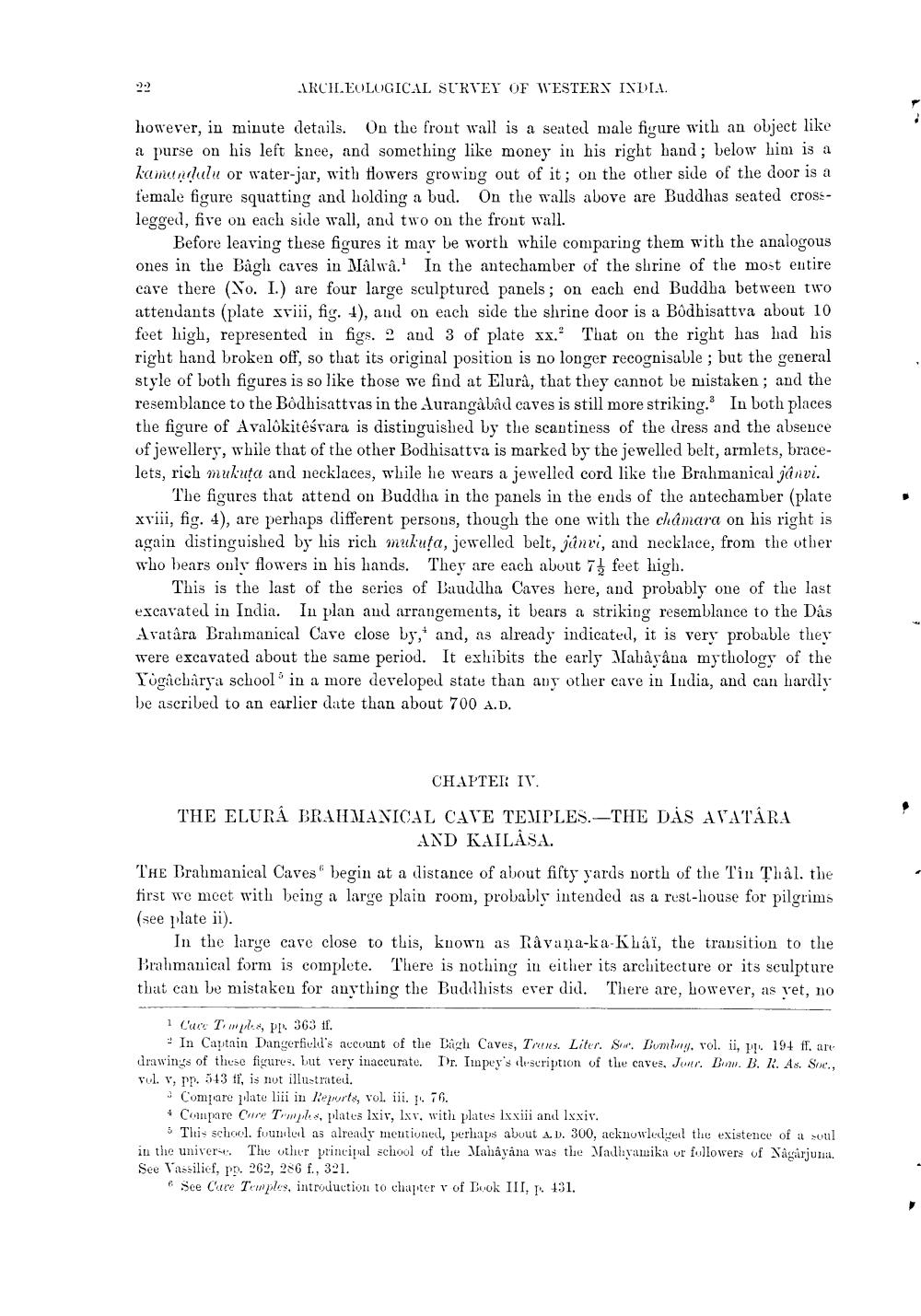________________
ARCHEOLOGICAL SURVEY OF WESTERN INDIA.
however, in minute details. On the front wall is a seated male figure with an object like a purse on his left knee, and something like money in his right hand; below him is a kamandalu or water-jar, with flowers growing out of it; on the other side of the door is a female figure squatting and holding a bud. On the walls above are Buddhas seated crosslegged, five on each side wall, and two on the front wall.
Before leaving these figures it may be worth while comparing them with the analogous ones in the Bâgh caves in Mâlwâ. In the antechamber of the shrine of the most entire cave there (No. I.) are four large sculptured panels; on each end Buddha between two attendants (plate xviii, fig. 4), and on each side the shrine door is a Bodhisattva about 10 feet high, represented in figs. 2 and 3 of plate xx. That on the right has had his right hand broken off, so that its original position is no longer recognisable; but the general style of both figures is so like those we find at Elurâ, that they cannot be mistaken; and the resemblance to the Bodhisattvas in the Aurangâbâd caves is still more striking. In both places the figure of Avalokitesvara is distinguished by the scantiness of the dress and the absence of jewellery, while that of the other Bodhisattva is marked by the jewelled belt, armlets, bracelets, rich mukuta and necklaces, while he wears a jewelled cord like the Brahmanical janvi.
The figures that attend on Buddha in the panels in the ends of the antechamber (plate xviii, fig. 4), are perhaps different persons, though the one with the châmara on his right is again distinguished by his rich mukuta, jewelled belt, janvi, and necklace, from the other who bears only flowers in his hands. They are each about 74 feet high.
This is the last of the series of Bauddha Caves here, and probably one of the last excavated in India. In plan and arrangements, it bears a striking resemblance to the Dâs Avatâra Brahmanical Cave close by, and, as already indicated, it is very probable they were excavated about the same period. It exhibits the early Mahâyâna mythology of the Yogacharya school in a more developed state than any other cave in India, and can hardly be ascribed to an earlier date than about 700 A.D.
CHAPTER IV.
THE ELURA BRAHMANICAL CAVE TEMPLES. THE DAS AVATARA AND KAILASA.
THE Brahmanical Caves" begin at a distance of about fifty yards north of the Tin Thal. the first we meet with being a large plain room, probably intended as a rest-house for pilgrims (see plate ii).
In the large cave close to this, known as Ravana-ka-Khâï, the transition to the Brahmanical form is complete. There is nothing in either its architecture or its sculpture that can be mistaken for anything the Buddhists ever did. There are, however, as yet, no
1 Care Temples, pp 363 ff.
In Captain Dangerfield's account of the Bagh Caves, Trans. Liter. Sr. Bombay, vol. ii, pp. 194 ff. are drawings of these figures, but very inaccurate. Dr. Impey's description of the caves, Jour. Bom. B. R. As. Soc., vol. v, pp. 543 ff, is not illustrated.
Compare plate liii in Reports, vol. iii. p. 76.
* Compare Cure Temples, plates lxiv, lxv, with plates lxxiii and lxxiv.
This school. founded as already mentioned, perhaps about A. D. 300, acknowledged the existence of a soul in the universe. The other principal school of the Mahayana was the Madhyamika or followers of Nagarjuna. See Vassilief, pp. 262, 286 f., 321.
See Care Temples, introduction to chapter v of Book III, p. 431.




